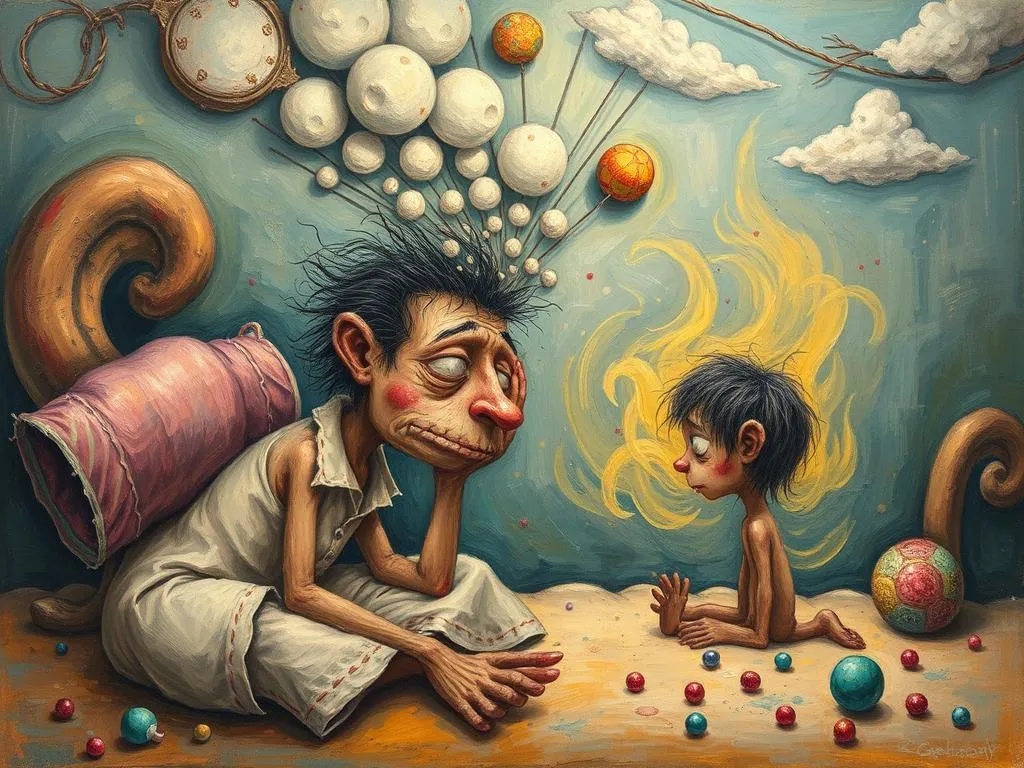
Have you ever woken up in a cold sweat, heart racing, after a night filled with nightmares? Those painful moments can feel distressing and confusing, leaving us to wonder about their significance. Dreams are a window into our subconscious, often revealing hidden fears, unresolved conflicts, and deeper truths about our lives. While these troubling dreams can feel like a dark cloud hanging over us, they also provide an opportunity for growth and understanding.
In this article, we’ll explore the symbolism behind painful dreams, analyze different experiences that may lead to such dreams, and discuss how they can ultimately lead to personal growth. Think of this as a conversation with a knowledgeable friend who understands the intricate tapestry of the mind and its messages. So, let’s dive into the depths of your dreams and uncover the wisdom hidden within.
Shadows of the Mind: Decoding Painful Symbols
When we dream, our minds communicate through symbols that are often deeply personal yet resonate with collective experiences. Painful dreams frequently feature symbols that carry significant weight. Let’s examine some common symbols found in such dreams:
-
Falling: This symbol can signify a loss of control or fear of failure. It’s often linked to feelings of inadequacy or anxiety, reflecting a situation in your life where you feel unsupported or overwhelmed.
-
Being chased: A classic dream scenario, being pursued in your dreams suggests avoidance. It might symbolize an unresolved issue that you are running away from, whether it’s a relationship, a responsibility, or an emotional pain that needs addressing.
-
Injury or illness: Dreaming of injury can represent feelings of vulnerability. It might indicate that you feel attacked or threatened in your waking life, or it could symbolize an emotional wound that has yet to heal.
-
Loss of teeth: Often associated with fears of aging, loss of power, or insecurity, this dream scenario can reflect anxiety about how others perceive you or concerns about your self-worth.
-
Natural disasters: Earthquakes, floods, or tornadoes in dreams can symbolize chaos and upheaval in your life. They may represent an emotional eruption that you’ve been trying to suppress or an external situation that feels beyond your control.
Understanding these symbols can help you connect with the underlying emotions and challenges they represent. Remember, while these symbols have common interpretations, your personal experiences will shape their meanings.
The Nightmares We Live: Personal Stories from Troubling Dreams
To better grasp how painful dreams manifest, let’s explore a few relatable scenarios. Each of these stories highlights the emotional landscape of the dreamer and the potential lessons buried within the dream experience.
-
The Exam Nightmare: Sarah, a college student, often dreams that she’s unprepared for an important exam. In these dreams, she finds herself frantically searching for her classroom, only to realize she’s late. This dream reflects her academic pressure and fear of failure. By recognizing this pattern, she can address her stress and seek support, ultimately leading to improved performance and peace of mind.
-
The Betrayal: Mark frequently dreams that his closest friend is betraying him. In his dream, he witnesses them laughing and chatting with someone he dislikes. This dream speaks to Mark’s insecurities about trust and connection. By confronting these feelings in his waking life, he realizes he needs to communicate more openly with his friend, strengthening their bond.
-
Weight of Responsibility: Emily dreams that she is carrying an enormous burden on her back, struggling to move forward. This dream is a manifestation of her overwhelming responsibilities at work and home. It highlights her need to delegate tasks and set boundaries. By recognizing this, Emily begins to prioritize self-care, leading to a healthier work-life balance.
-
A Fear of Public Speaking: Jason often dreams that he’s on stage, forgetting his lines in front of a large audience. This dream reflects his anxiety about being judged and fear of public speaking. By confronting this fear in real life—perhaps through joining a public speaking group—he can transform this anxiety into confidence, both in dreams and reality.
-
The Lost Child: Maria has recurring dreams of losing her child in a crowded place, frantically searching and calling out their name. This reflects her deep-seated fears around parenting and loss. By addressing these fears through open conversations with her partner and seeking support, she can reclaim her sense of security and confidence as a parent.
These scenarios illustrate how our dreams can mirror our waking lives, offering insights into our most profound vulnerabilities and fears. Each dream serves as a guide, illuminating paths toward resolution and understanding.
Healing Through Nightmares: Embracing Personal Growth
Rather than fearing your troubling dreams, consider them as tools for personal growth. Embracing the lessons they offer can foster a deeper understanding of yourself. Here are some practical insights on how to navigate through these painful dream experiences:
-
Keep a Dream Journal: Write down your dreams as soon as you wake up. Documenting your dreams can help you identify recurring themes and symbols, providing clarity about your emotional state. Over time, this practice can unveil patterns and guide you toward resolution.
-
Reflect on Your Emotions: After recording your dreams, take a moment to reflect on your feelings. What emotions surfaced during the dream? How do these emotions connect to your waking life? Engaging in this reflective process can lead to profound insights.
-
Practice Mindfulness: Incorporate mindfulness techniques into your daily routine, such as meditation or deep breathing exercises. These practices can help you manage anxiety and stress, which may reduce the frequency and intensity of troubling dreams.
-
Seek Support: If specific dreams are particularly distressing, don’t hesitate to reach out for support. Talking to a trusted friend, therapist, or counselor can provide an outside perspective and help you navigate complex emotions.
-
Embrace Change: Finally, recognize that dreams often signal the need for change. Embrace the feelings they evoke, and allow them to motivate you to take action in your waking life. Whether it’s setting boundaries, addressing fears, or pursuing a passion, these dreams can serve as catalysts for transformation.
As you embark on this journey of understanding your dreams, remember that they are not merely a collection of chaotic images. Instead, they hold wisdom and insight, waiting for you to uncover their secrets. Each night when you close your eyes, you have the opportunity to explore the depths of your mind and emerge with newfound clarity.
In conclusion, the next time you find yourself grappling with a troubling dream, take a moment to pause and reflect. Your subconscious is communicating with you, urging you to pay attention to the painful moments that may be simmering beneath the surface. By engaging with these dreams and the emotions they evoke, you can embark on a transformative journey toward self-discovery and healing. Remember, it’s not just about deciphering the symbols; it’s about embracing the lessons they offer and allowing them to guide you toward a more fulfilling life.
Dreams are merely the whispers of your soul, urging you to listen, learn, and grow.







